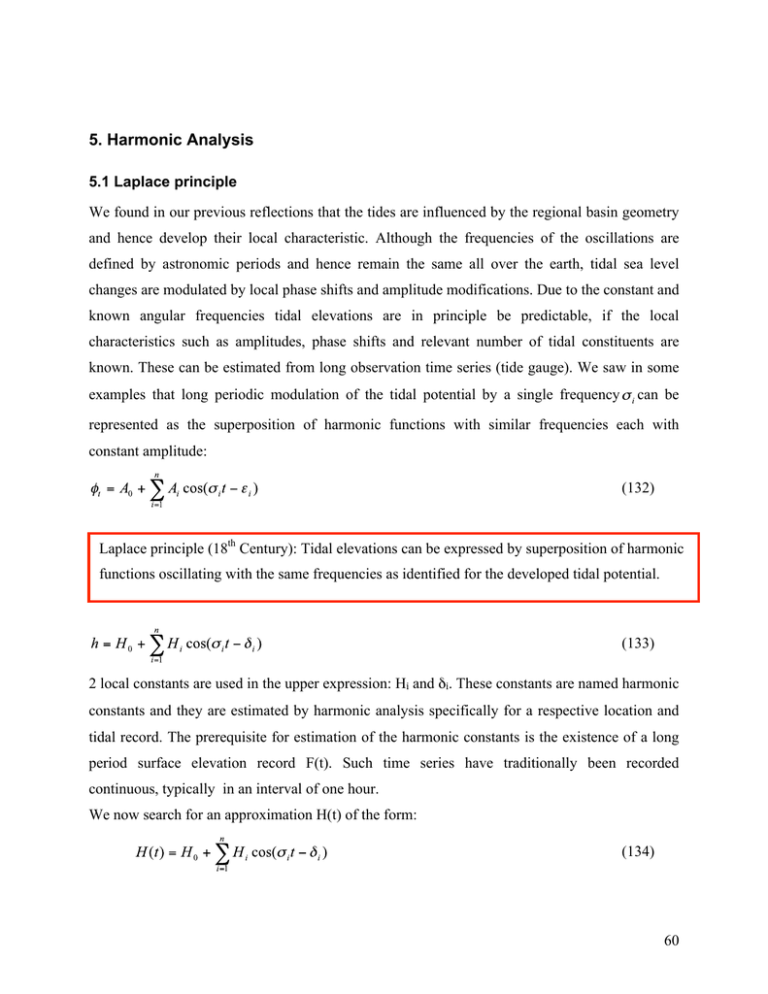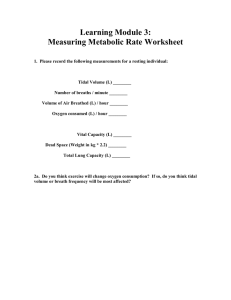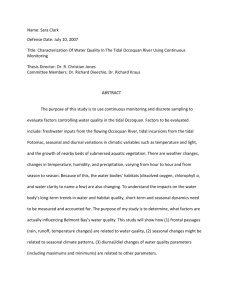5. Harmonic Analysis
advertisement

5. Harmonic Analysis 5.1 Laplace principle We found in our previous reflections that the tides are influenced by the regional basin geometry and hence develop their local characteristic. Although the frequencies of the oscillations are defined by astronomic periods and hence remain the same all over the earth, tidal sea level changes are modulated by local phase shifts and amplitude modifications. Due to the constant and known angular frequencies tidal elevations are in principle be predictable, if the local characteristics such as amplitudes, phase shifts and relevant number of tidal constituents are known. These can be estimated from long observation time series (tide gauge). We saw in some examples that long periodic modulation of the tidal potential by a single frequency can be represented as the superposition of harmonic functions with similar frequencies each with constant amplitude: (132) Laplace principle (18th Century): Tidal elevations can be expressed by superposition of harmonic functions oscillating with the same frequencies as identified for the developed tidal potential. (133) 2 local constants are used in the upper expression: Hi and δi. These constants are named harmonic constants and they are estimated by harmonic analysis specifically for a respective location and tidal record. The prerequisite for estimation of the harmonic constants is the existence of a long period surface elevation record F(t). Such time series have traditionally been recorded continuous, typically in an interval of one hour. We now search for an approximation H(t) of the form: (134) 60 with defined constants Hi and δi such as H(t) best fits the observed elevation time series F(t). The number of harmonic contributions considered (n+1) specifies the degree of approximation with the upper limit being the number of harmonic contributions currently estimated (396 after Doodsen, 1921). Furthermore, the practical issue of a finite length of the observational time scale defines a limitation for the number of components to consider (and consequently for the accuracy). This is especially the case for the long periodic components in the spectra. The best fit of Hi and δi can be estimated by the least square fit method. The difference between fit and observed time series is estimated for each time step: (135) and we search for the values Hi and δi resulting in minimum values for the sum of squared differences (136) For practical purposes the time series H(t) is presented in the form: (137) We than can interpret the quadratic sum as a function of coefficients Ai and Bi and search for the minimum of G(A0,Ai,Bi ) by finding the zero of the derivatives of G with: (138) These conditions give 2n+1 equations for 2n+1 unknowns. The respective equations have the form: (139) since (140) follows (141) or in detail 61 m m n n ∑ F(t)cosσ i t =∑[A0 + ∑ Ai cos(σ i t) + ∑ Bi sinσ i t ]cosσ i t t=1 t=1 m m t=1 n i=1 m n (142) = ∑ A0 cosσ i t + ∑ cos σ i t ∑ Ai cos σ i t + ∑ cos σ i t ∑ Bi sin σ i t i=1 € i=1 i=1 i=1 i=1 Corresponding sets of equations are received by using the last equation of (138). m is in general a quite large number (with hourly time step already 8760 for every year), hence solving the upper equations is a huge task and a fast solver with high performance are needed. For an almost complete estimation, about 390 harmonic components are needed. To reach a high degree of accuracy about 115 semi-diurnal, 160 diurnal and 100 long periodic components are needed to be considered. Less accurate with a still sufficient degree of accuracy can be achieved using a much lower number of harmonic components. 5.2 Tidal prediction with 7 components From a tidal table from a nearby observation point, we can find out the frequencies and the harmonics constants for the 7 most prominent spectral lines. If we neglect the long-periodic contributions, especially the half-year and yearly contributions, the 7 most important contributions are K2, M2, N2 and S2 (semi-diurnal) and K1, O1 and P1 (diurnal). Tidal prediction will be performed based on the same principles as used in the previous section, i.e. we apply a formulae of the type: (155) Time is thereby counting from beginning of every year, phase δi is therefore related to a calculation of time which begins at New Year every year. The general phase δi will be separated into two contributions, (V0+u)i and χi. (V0+u)i is the equilibrium phase of the tidal component (in the tidal potential) to the 0-meridian at New Year and χi is the epoch of the tide, the own anomaly of the tidal component from the equilibrium tidal phase. It is common praxis to further split up the epoch of a tide into a local contribution and a contribution depending on geographic length. 62 Equilibrium phase can be found in standard tables, normally published for many years in advance. In the following table, you find harmonic constants for Bergen together with the equilibrium phase and epoch for 1.1.1990. Component Frequency Amplitude Epoch Vo+u K1 15,04107 3,2 cm 170 16,7 O1 13,94304 3,0 cm 17 240,1 P1 14,98593 1,1 cm 152 349,6 K2 30,08214 4,6 cm 337 213,9 S2 30 15,8 cm 335 0 M2 28,98410 43,9 cm 298 259,4 N2 28,43973 8,4 cm 270 324,3 Using the upper table as a starting point, we are able to perform a tidal prediction for a full year. For a more precise estimation we’ll perform the analysis for a month and start every month under consideration of a new equilibrium tidal phase at the beginning of the respective month (found in additional tables). 6 Appendix 6.1 Harmonic analysis of short time series In case we would like to find a mathematical representation of tidal contributions from a much shorter time series, e.g. for observations of tidal currents, which in contrast to the surface elevation, are typically observed only during a short period of instruments deployment, the previous type of analysis can not be applied. Here we need another approach to receive a mathematic representation for the periodic contributions. Although surface elevation records are typically available for long time periods, limitations using the previous analysis method could arise as well in case of analysing daily variations of surface elevation. If the temporal variability of observations is related to tidal forcing, it is near by hand to introduce moon hours (to simplify) as time variable, which we’ll use in the following. We furthermore have to consider, that in 63 addition to the tidal forcing from the tidal potential, real surface elevations are partly caused by resonance, which can occur on shorter time scales than 12h. Hence, we’ll find periodic oscillations with periods shorter than 12 hours. This might create a significant contribution of short periodic disturbances, which we have to account for to enable realistic prediction. We therefore need to include representation of higher harmonic components, which cannot be found from celestial periods. We assume that the observed height X(t) can be represented by the following series approximation: (143) where σ is the basic diurnal frequency with 2π/24 rad/h and t is measured in moon hours. Hence we consider diurnal and semidiurnal tidal variations and high frequency disturbances (resonance and unresolved long periodic variability). We multiply the equation with cos (nσt) and integrate over one (moon) day. As generally known, we’ll have only a contribution from the first term of the series (An –coefficient), namely: (144) with introduction of ω=nσt (144) reduce to (145) The amplitudes An can therefore be estimated by the following equation: (146) Accordingly we’ll find that In practice, the variable will be reported as an hour value (or discrete). Hence, we need to discretize the above form. Below we’ll find the expression for the daily basic diurnal frequency (n=1): 64 (147) (148) Similarly we get the coefficients for the semi-diurnal components (n=2): (149) (150) Components of higher harmonic frequencies can be estimated in the same way. Removing of trends For the upper analysis we assumed that the observed disturbance behave periodic. In case this is not true, we’ll fail in calculating the amplitudes using the upper method. We can avoid this by correcting the observation material from irregularities. Particularly, trends have to be removed from the observations, i.e. A0 is not a constant, but varies with observation period A0= A0(t). We compensate for such trends by reconstructing a data set without such a trend but conserving the main periodic features of the time series. For the daily oscillation we’ll achieve this by: replace X0 by (X0 +X23)/2 and replace X1 by (X1+X22)/2 etc. in the cosine summation, but use the half-difference for the sine summation. Filtering In oceanography we use a series method to remove high frequency disturbances. In case of long time series, such disturbances are normally no problem and it is not necessary to apply particular methods to remove these before performing the upper analysis. However, for shorter time series, these disturbances might cause failure of the upper analysis and we need to remove them before we perform a harmonic analysis. Here we won’t discuss the more advanced methods for filtering, but introduce a simple filter, i.e. the moving averaged. This method is widely applied in oceanography and particularly used for analyzing tidal records. In dependence of the observational material which is typically available in hourly resolution, appropriate filtering of 65 high frequency disturbances can be achieved by creation of an average for every hour in the form: (151) The interval used for averaging depends on the frequencies of the disturbances, but normally 4 hours are sufficient. While performing filtering, we need to account for that we’ll flatten as well the tidal signal while averaging, and hence we have to compensate for this effect. The flattening of signals will be stronger for higher frequencies, i.e. compensation factors for semi-diurnal periods will be stronger than for diurnal periods. A useful 36-hours analysis method compensated for trends In case of short time series, observed only over a couple of days, we cannot hope to extract many daily or half daily or longer periodic components. Nevertheless, such a time series can be useful to study the semi-diurnal and diurnal tidal characteristics and possible longer periodic contributions, e.g. if an experiment is performed during spring and neap tide, it is possible to represent the tidal phenomena as a composite of 2 respective components. This can be achieved by using the following useful method, which uses series with at least 37 hourly values. The calculation will be repeated every 12th or 24th hours in dependence of the length of the time series. The method was developed for calculation by hand, but can be easily programmed on a PC. Starting point of calculation is the time series, i.e. the first 37 hour steps of the observed surface elevation as a 6x7 matrix Mij: Mij = X1 X7 X13 X19 X25 X31 X2 X8 X14 X20 X26 X32 X3 X9 X15 X21 X27 X33 X4 X10 X16 X22 X28 X34 X5 X11 X17 X23 X29 X35 X6 X12 X18 X24 X30 X36 X7 X13 X19 X25 X31 X37 From this matrix we can now calculate a vector Si by multiplication Si=MijFj 66 whereby Fj is a vector with the following 6 elements: Fj =(‐1, 3, ‐4, 4, ‐3, 1) Multiplication with Fj represents a way of averaging of the assumed harmonic characteristic of the variable. The resulting vector Si is a consist of weighted sums, i.e. S1 is a weighted sum with contribution of term 1, 7, 13, 19, 25 and 31. This particular weighting gives the most weight to contributions which are in the centre of the time series. Si has 7 elements, which cover a half period centred around the centre value of the time series X19. Further smoothing can be reached by pair‐wise subtraction and addition of values which are found in equidistance from centre value S4, hence: M1=S1‐S7 N1=S1+S7 M2=S2‐S6 N2=S2+S6 M3=S3‐S5 N3=S3+S5 M4=S4‐S4 N4=2S4 M‐time series will now contain the respective sinus contribution, distributed by hour time steps 3,2, 1 and 0 hours from central values X19. The respective N‐time series contains the cosine contribution. The actual harmonic analysis will be performed by defining values Y and Z by integration of the reduced Si, to be multiplicated by cos(nσt) and sin (nσt), respectively: (152) (153) The resulting heights Y and Z are both relative measures of contributions of Acos σt and Bsinσt. The respective amplitudes A and B are received by reducing: and (154) This is without a compensation for high frequency noise. It is easy to understand that the averaging from above as well removes trends from the observational material. 67 6.2 Analysis of rotating tidal currents Observing the currents in a fixed location in the sea, we’ll find tidal currents with overlaid residual currents. By removing the residual current, we’ll realize that the tidal currents form a periodic rotation of current vectors together with periodic variations in the current speed, both usually not in phase. We separate such a time series by decomposition into 2 main current directions, i.e. into an eastward component u(t) and a northward component v(t). Assuming a tidal disturbance varying with the main frequency σ, which is typically semi-diurnal, we can than estimate the periodic variation in the 2 (horizontal) current components by: (156) Or using an equivalent description: (157) Instead of the 4 coefficients M,N, P and Q we use 2 amplitude coefficients and 2 phase angles α and β, with (158) We than can find that (159) and (160) Let us now discuss the combined tidal phenomena. First, we concentrate on the absolute current speed V, with (161) 68 This equation tells us, that the current speed varies harmonically between 2 extremes. Maximum values will occur when (162) Hence in case of: (163) or (164) Maximum value of V is A+B. Analogous we can find the minimum values appears at (165) and hence (166) The minimum value is V=A-B. The upper equations predict also the time when the components of tidal currents are at maximum, i.e. along the large half axis. Currents are at minimum along the small half axis. Estimation of position of the half axis will be found by in the following. Direction of the current vector V(u(t),v(t)) varies in t with u(t) and v(t). Assuming the angle between the current vector and the x-axis counting positively in anticlockwise direction, we’ll find the direction of the large half axis by (167) This can be reduced to (168) The large half axis has therefore an orientation of: (169) 69 Literature Cartwright, DE, Tides –A scientific history, Cambridge University Press. Gade, HG. Tidevann og tidevannstrømmer, Teori, opptreden, analyse og prediksjon, lecture notes of GEOF331, in Norwegian Gjenne, B, Simmensen, T, 1963. Tidal choking in the landlocked fjord of Norddåsvatnet. Sarsia, 11, 43-73. Ippen, AT ed., 1966. Estuary and coastline hydrodynamics. McGraw-Hill Book Comp. 744 pp. Jensen, E., 1977. Tidevannet I oslofjorden, og strøm og hydrografi I Drøbaksundet juni/juli 1972. Hovedfagsoppgave I geofysikk, Univ. i Oslo. Kvinge, T, Lee, AJ, Sætre, R, 1968. Report on study of variability in the Norwegian Sea April/May 1967. Geofysik inst., Univ. i Bergen. Mcclimans, TA, 1978. On the energetics of tidal inlets to landlocked fjords. Mar. Sc. Comm. 4. 121-137. Proudman, J, Doodson, AT, 1924. The principal constituent of the tides of the North Sea. Philosophical Transactions of the Royal Society of London. Series A, Containing Papers of a Mathematical or Physical Character, Vol. 224. (1924), pp. 185-219. Pugh, DE, Tides, Surges and Mean Sea Level, John Wiley & Sons. Stewart, RH, Introduction to Physical Oceanography, Department of Oceanography, Texas University. Stigebrandt, A., 1980. Some aspects of tidal interaction with fjord constructions. Est. Coast. Mar. Sc. 11, 151-166. 70



